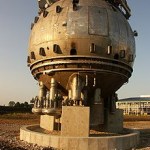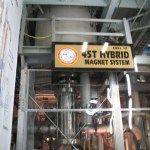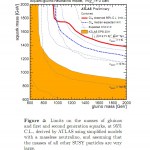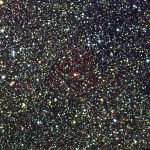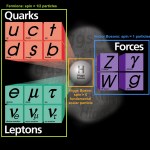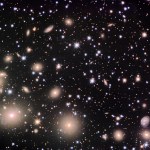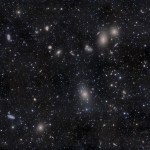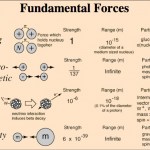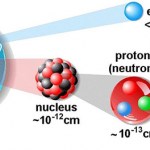lhc
Here are some more unsung heroes of research: scanners (the human kind). In the 1950s, Donald Glaser invented the bubble chamber – a way to track infinitesimally small quantum particles as they winked in and out of existence. The idea – which may or may not have been tested in beer – was to create a large chamber of liquid under pressure next to a particle accelerator. As the beams hit their target, producing sprays of new types of short-lived particles, these energetic particles would leave tracks of bubbles in the liquid (usually hydrogen). Everything was caught on arrays of special high-…
"It is no good to try to stop knowledge from going forward. Ignorance is never better than knowledge." -Enrico Fermi
As you probably know, the Large Hadron Collider -- site of discovery of the last fundamental particle in the Standard Model, the Higgs Boson -- is the most energetic particle accelerator in the history of humankind. When the upgrades it's currently undergoing are complete, it will reach collision energies of 14 TeV.
Image credit: CERN / LHC, add-on created by http://www.panglosstech.com/.
The way this happens is that protons are circulated in a giant ring, underground,…
“Supposedly she’d died, but here she was again–somewhat changed, but you couldn’t kill her. Not when the truest part of her hadn’t even been born.” -Denis Johnson
Over the past 100 years, our picture of the Universe has changed dramatically, on both the largest scales and the smallest.
Image credit: Richard Payne.
On the large-scales, we've gone from a Newtonian Universe of unknown age populated only by the stars in our own Milky Way to a Universe governed by General Relativity, containing hundreds of billions of galaxies.
Image credit: Rhys Taylor, Cardiff University.
The age of this…
"All our sweetest hours fly the fastest." -Virgil
If you've been around the block once or twice, you know that the speed of light in a vacuum -- 299,792,458 meters-per-second -- is the absolute maximum speed that any form of energy in the Universe can travel at. In shorthand, this speed is known as c to physicists.
Image credit: user Fx-1988 of deviantART.
But you or I, no matter how hard we try, will never attain that speed. There's a simple reason for this: we have mass. And for an object with mass, you can accelerate it all you want, but it would take an infinite amount…
"If you're a reporter, the easiest thing in the world is to get a story. The hardest thing is to verify. The old sins were about getting something wrong, that was a cardinal sin. The new sin is to be boring." -David Halberstam
It was only a few months ago that both collaborations at the Large Hadron Collider in CERN -- CMS and ATLAS -- announced the discovery of a new particle at about 125-126 GeV of energy: something that looked an awful lot like what the Standard Model predicted the Higgs Boson should be.
Image credit: the CMS detector at CERN, 2009.
This was the result of decades of…
"...this consensus has been brought about, not by shifts in philosophical preference or by the influence of astrophysical mandarins, but by the pressure of empirical data." -Steven Weinberg
One of the most fundamental questions we could ever ask about all of existence is "What makes up the Universe?"
Image credit: Misti Mountain Observatory.
I don't mean "stars and galaxies," like you see above. That might make up the Universe on the largest scales, but that's taking a look at the question of what the fundamental constituents of the Universe compose themselves into.
The other side of the…
"The particle and the planet are subject to the same laws and what is learned of one will be known of the other." -James Smithson
The entirety of the known Universe -- from the smallest constituents of the atoms to the largest superclusters of galaxies -- have more in common than you might think.
Image credit: Rogelio Bernal Andreo of http://blog.deepskycolors.com/about.html.
Although the scales differ by some 50 orders of magnitude, the laws that govern the grandest scales of the cosmos are the very same laws that govern the tiniest particles and their interactions with one another on the…
Continuing slow live blog of the “New Particle Physics at the LHC and Its Connection to Dark Matter” workshop at the Aspen Center for Physics.
Series of short talks this morning:
"A WIMPy Baryogenesis Miracle" by
Yanou Cui, Lisa Randall, Brian Shuve (arXiv:1112.2704) interesting and possibly useful speculation on how electroweak scale WIMPs could couple to normal matter in early universe and actually generate some or all of the normal matter, in particular in such a way as to generate the observed matter/anti-matter asymmetry.
Aside: Quantum Diaries has the down and dirty details of the Higgs…
"New Particle Physics at the LHC and Its Connection to Dark Matter" is the name of the current workshop at the Aspen Center for Physics running through Sep 9th.
I'm hanging out for the first few days and the first presentation is on "what has the LHC Higgs done to supersymmetry"?
So, basic point is that supersymmetry sort of predicts that the Higgs mass (125 GeV) should be close to the Z mass (91 GeV), up to some corrections. So the mass corrections can be parametrised in perturbative theory, and how do you nail a ~ 30% correction and keep everything natural?
We talk about our feelings.
We…
Last talk of the LHC Shows the Way workshop, with the most provocative title.
Entries in this post may or may not be mangled misrepresentations of stuff the speaker made up just to be provocative...
Starting point: there is something at ~ 125 GeV and it is consistent with a boson, possibly a scalar, and quite likely a standard model Higgs boson.
Agreed.
Preliminary results for CMS experiments show branching ratio to ττ decay mode a little bit lower than normal.
ATLAS initially did simple crude analysis of this channel.
Now redone with more data and better technique.
ATLAS expect to make…
The LHC Shows the Way workshop is about to end, and the slow live blog limps along with a presentation on the composite Higgs.
A model for having a light (~ 100 GeV ) scalar, is to have a composite Higgs instead of the alternative of either a true supersymmetric model or a light dilaton scalar.
As with such models in general, they violate unitarity if extrapolated to higher energies, so force a new energy scale, at, say, few TeV - like another particle there (cf old effective weak interaction theory).
Yes, if you work it out in detail, the effective coupling runsaway and you need to truncate…
Back at the LHC Shows the Way workshop at the Aspen Center for Physics - more discussion of Higgs alternatives and peculiar branching ratios.
No, the branching ratios for the different decay modes of the 125 GeV boson that is putatively the Higgs are not anomalous at a statistically significant level, but, they are off a bit.
So, theorists go wild with ecstatic speculation - it is fun and not yet ruled out by data, what else can we do!
This morning Fan on 2:1 for Naturalness at the LHC? by Nima Arkani-Hamed, Kfir Blum, Raffaele Tito D'Agnolo, JiJi Fan
Later there will be discussion on jet…
Back at the LHC Shows the Way workshop and slow live blogging of the discussion, with random asides for other stuff...
Astronomy Magazine has a contest - win Brian May's PhD thesis! - now separate post with added bonus question
Today:
fake Higgs - are there some new bosons which are not Higgs, but which look like Higgs. Specifically looking at other scalar or pseudoscalars, or the possibility of spin-2 tensor particles.
Aside: cool 2D fluid flow web site - GPU powered 512k sim run live through WebGL - hypnotic turbulence to crash your browser
Look for general models where some particle…
Continuing lazy live blog of the LHC Shows the Way workshop, with random interludes of alternative considerations, including the more esoteric aspects of German finance...
Patio session (informal presentation of in-progress results on blackboard, outside) - didn't catch speaker's name, got here a couple of minutes late.
Being reminded that Higgs is not the only scalar that may exist out there - could the LHC 125 GeV bump be a dilaton?
Paper by Csaki and collaborators coming out in August on arXiv.
Aside: the proliferation of chargeless scalars in quantum field theories has always bothered me…
LHC Shows the Way workshop: general colloquium reviewing the LHC and the Higgs discovery.
Kyle Cramner from NYU: "We discovered the goddamned particle"
More slow live blog.
Cute opening video of LHC construction.
Factoid: kinetic energy of LHC beam is about that of a jumbo jet at cruise speed
Starting point: Standard Model is ridiculously successful, at the part per million quantitative level.
In the regime in which it is valid.
Add Higgs and you don't just get mass, you get coupling to fermion decay is proportional to the Higgs induced mass of the fermion.
Can calculate Higgs boson…
The LHC Shows the Way workshop rolls on, looking at the implications of the Higgs at 125-126 GeV for supersymmetry.
I live blog, slowly.
Where are the sparticles.
Coloured supersymmetric partners, the quark and gluon supersymmetric partners, must be massive - greater than ~ 1,000 GeV
in some natural implementation of supersymmetry, natch, clever theorists can of course think of increasingly contrived ways to get around most any limit, at the expense of fewer and fewer people believing them.
Minimal supersymmetric extensions to the standard model, with the Higgs mass assumed to be 126 GeV and…
This three-story-tall mural was painted by international artist Josef Kristofoletti on the side of the ATLAS control room directly above the detector:
This project was inspired by the same questions that physicists are trying to answer; where did we come from, what does it mean to be human, and what is our place in the universe? The artist worked closely with physicists at CERN over the course of a year to create the mural. It depicts the artist's interpretation of what the Higgs boson might look like.
This short, time-lapse video was finished June 2012, using photos that were taken…
"Even if there is only one possible unified theory, it is just a set of rules and equations. What is it that breathes fire into the equations and makes a universe for them to describe?" -Stephen Hawking
After a long search spanning more than my entire lifetime (so far), the Higgs boson has finally been discovered at both detectors -- CMS and ATLAS -- at the Large Hadron Collider at CERN.
Image credit: CERN / Particle Physics for Scottish Schools.
For a little more on this, check out the earlier posts here celebrating Higgs week:
The Biggest Firework of them all: The Higgs
How the…
"We knew that we had indeed done something that was very different and very exciting, but we still didn't expect it to have something to do with physical reality." -Gerald Guralnik, co-developer of the Higgs mechanism
Might as well make this entire week "Higgs week" here on Starts With A Bang, given how important yesterday's discovery/announcement was! It isn't every day, after all, that you see a theoretical physicist on the 7PM news. (Video here.)
Image credit: KGW.com.
(So proud of Portland, OR's local TV station, KGW NewsChannel 8, for being willing to promote science to the whole city…
"Give me a coin. <Takes Coin.> All right. Uh... heads, I win, tails, you lose. Right? <Flips coin.> Tails, you lose." -Ralph Kramden
All things being equal, you're well aware that if you flipped a completely fair coin, you'd have a 50% chance of it landing on heads, and a 50% chance of landing on tails (ignoring the side, of course).
Image credit: C. Nolan, A. Eckhart and Warner Bros. Pictures, retrieved from http://explow.com/Two-Face.
So let's imagine that you flip the coin ten times, and you get seven heads and three tails. Are you worried? You shouldn't be; in…
